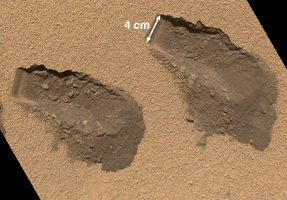
Annotated Image
Click on the image for larger versionThis is a view of the third (left) and fourth (right) trenches made by the 1.6-inch-wide (4-centimeter-wide) scoop on NASA's Mars rover Curiosity in October 2012. The image was acquired by the Mars Hand Lens Imager (MAHLI) on Sol 84 (Oct. 31, 2012) and shows some of the details regarding the properties of the "Rocknest" wind drift sand. The upper surface of the drift is covered by coarse sand grains approximately 0.02 to 0.06 inches (0.5 to 1.5 millimeters) in size. These coarse grains are mantled with fine dust, giving the drift surface a light brownish red color. The coarse sand is somewhat cemented to form a thin crust about 0.2 inches (0.5 centimeters) thick. Evidence for the crusting is seen by the presence of angular clods in and around the troughs and in the sharp, jagged indentations and overhangs on one wall of each trench (the walls closest to the top of this figure).
Beneath the crust surface, as revealed in the scoop troughs and the piles of sediment on the right side of each, is finer sand, which is darker brown as compared with the dust on the surface. The left end of each trough wall shows alternating light and dark bands, indicating that the sand inside the drift is not completely uniform. This banding might result from different amounts of infiltrated dust, chemical alteration or deposition of sands of slightly different color.
JPL manages the Mars Science Laboratory/Curiosity for NASA's Science Mission Directorate in Washington. The rover was designed, developed and assembled at JPL, a division of the California Institute of Technology in Pasadena.
For more about NASA's Curiosity mission, visit: http://www.jpl.nasa.gov/msl, http://www.nasa.gov/mars, and http://mars.jpl.nasa.gov/msl.

